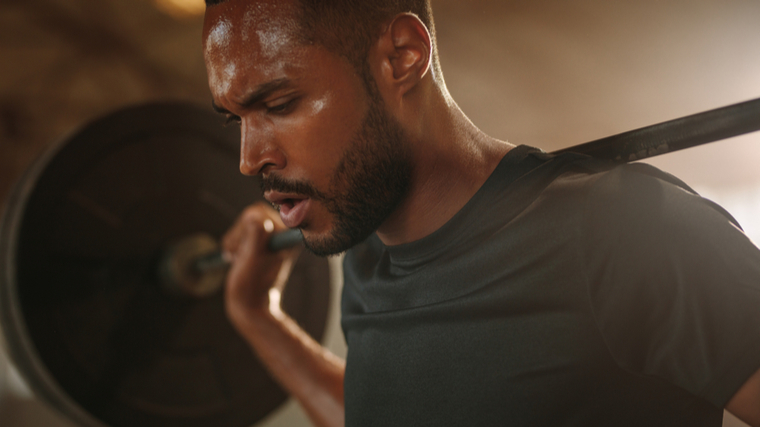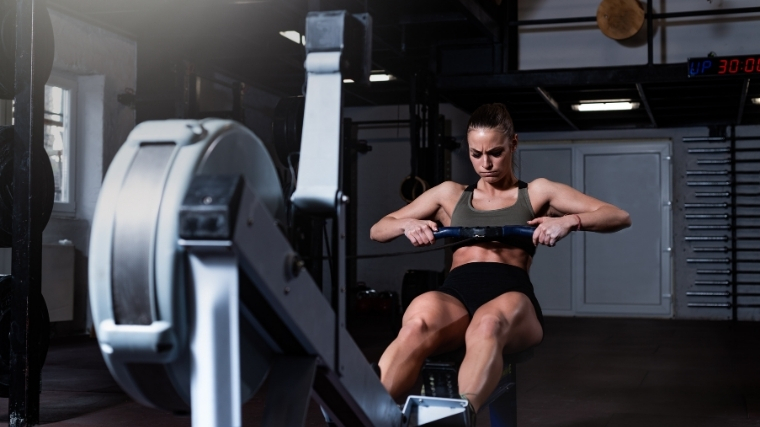Your conditioning has to be on point if you want to improve your performance both in and out of the gym, or if you happen to be invested in changing your physique. But what is conditioning exactly? Conditioning is a catch-all used to describe your work capacity, or your ability to lift weights, sprint, and maintain an elevated heart rate for an extended period of time.
A well-conditioned athlete will be able to pump out more reps in the gym, pack on more muscle, lose fat more quickly, and be all-around healthier. That’s because the person focusing on conditioning is working on every aspect of fitness — strength, power, endurance, coordination, flexibility, and more.

Yet too often, workouts are categorized as muscle-building or endurance sessions — forcing you to pick between one or the other. It doesn’t have to be that way, and in this article, we’ll explain why you should work on your body’s conditioning to improve your strength and agility in and out of the gym.
All About Body Conditioning
- What Is Conditioning?
- Benefits of Conditioning
- How Conditioning Works
- How to Program Conditioning
- Who Should Do Conditioning Work
Editor’s Note: The content on BarBend is meant to be informative in nature, but it shouldn’t take the place of advice and/or supervision from a medical professional. The opinions and articles on this site are not intended for use as diagnosis, prevention, and/or treatment of health problems. Speak with your physician if you have any concerns.
What Is Conditioning?
You may hear some people describing conditioning as a synonym for cardio. While there are some similarities, there are some significant differences. Both require elevated heart rates, and both aim to help you lose fat and increase your endurance.
A good way to describe the difference between the two is that cardio workouts will help you run from your car to the front door, while conditioning will allow you to do that while carrying every grocery bag in your trunk in one trip without stopping halfway. It’s a unison of strength and cardio. In other words, you’re getting stronger and faster — all while losing body fat — by focusing on conditioning.

Conditioning also puts different stressors on the body. Cardio requires steady movements, such as running rowing or biking, but conditioning puts you through explosive movements in short periods of time.
The movements are not steady like running on the treadmill but instead require explosive movements in a short period of time (think a one-minute burpee drill or 30 seconds of box jumps). During cardio, there’s going to come a time when your heart rate steadies itself — not so during conditioning exercises. Your heart rate will go up, drop during your rest periods, and then it goes back up on your next set.
Sure, these workouts will improve your endurance just as a sprint would, but you’re also working your muscles and improving your strength at the same time. So you’re burning calories during the workout, and because you’re toning your muscles, you’ll be set up for long-term fat loss as well.
Benefits of Conditioning
The benefits of improving your conditioning are vast, and we could do a separate piece just running down why you should do it. Here are just a few reasons.
Decreased Risk of Injury
Let’s revisit the grocery trip example. A strong athlete might be able to pick up the bags but if they’re not properly conditioned, then it’s a long trip to the kitchen. They might find themselves putting it down to avoid stressing their muscles and running the risk of injuring them (not that a jug of milk would tear your biceps off the bone, but it could cause some discomfort). A more apt example would be strongman athletes performing farmer’s carries.

They need to be very strong to pick up those handles (which can weigh hundreds of pounds), but then they need to carry them quickly and for long distances sometimes.
A study in the Clinical Journal of Sports Medicine found that most hockey injuries occur toward the end of each period and at the end of games. (1) Another study in the British Journal of Sports Medicine found injuries were more likely to happen in the second half of a rugby game, specifically the third quarter. (2)
Conditioning will help athletes play at higher levels for longer — it’s the reason why an athlete like Lebron James averages more than 35 minutes per game during the NBA Playoffs. The dude has some serious work capacity.
More Muscle-Building (and Fat-Burning) Capacity
Another benefit is that you’ll likely be able to pack more muscle onto your frame through conditioning workouts than strength workouts alone. A 2010 study backed this up, noting high-intensity interval exercises “brings about significant skeletal muscle adaptation.” (3)
We know that more muscle equals increased fat burn, but conditioning will also bring about much more. The same 2010 study also found that high-intensity interval exercises “significantly lowers insulin resistance,” which may help treat or delay type-II diabetes. (Though, you shouldn’t rely on conditioning work to treat any ailments. Always refer to your doctor for medical conditions.)

Another study published in the Journal of Strength and Conditioning found that a 10-minute kettlebell swing drill (with 35 seconds of work, followed by 25 seconds of rest before repeating) produced similar aerobic gains to a 10-minute treadmill run. (4)
The kettlebell drill also resulted in muscle activation and increased strength, something you can’t get on the treadmill.
Improved Memory
Sure, there are lots of physical benefits to conditioning workouts, but there’s a mental plus as well. A 2019 study found that middle-aged and older adults who participated in a strength and conditioning workout regimen had improved memories compared to their peers. (5)
Better Coordination
Have you ever tried to walk across a thin line while keeping your balance? It’s harder than it sounds, right? That is unless you have great coordination. A great way to improve that is, you guessed it, conditioning workouts.
A 2015 study found published in the Journal of Sports Science and Medicine found that young soccer players who practiced jump roping regularly improved greatly in running and dribbling than those who stuck to soccer-specific drills. The researchers concluded that using jump ropes is a great way to improve balance and motor coordination. (6)
This is because jump roping requires total body control — you’re using your upper half, your hands, as well as the lower-half, your feet, of your body during the drill. By doing this, you’re helping your body better communicate with itself.
How Conditioning Works
Now that you know why you should be doing conditioning workouts, here’s how to do it.
Conditioning is about combining cardio and resistance work to raise your heart rate, improve your stamina, recruit your muscles, and make you stronger. It also involves multiple muscle groups, and most of the time, involves full-body movements. Some examples are:
- Sled Drags or Pushes
- Battle Ropes
- Tire Flips
- Box Jumps
- Burpees
- Boxing
- Swimming
- Row Machines
- Kettlebell Swings
- Farmer’s Walks
Conditioning work, though, requires more than just making the right moves. At the heart of this method, pun intended, it’s about varying your heart rate throughout your workout.
To make sure you’re in the right heart rate zone, you’ll need to figure out your maximum heart rate, which is just the cap on the number of times your body should be beating per minute during exercise.
You can do this by undergoing a test, but an easy way to figure it out is to take 220 and subtract your age. So if you’re 30, your maximum heart rate is 190. (This isn’t scientific, and this number can vary depending on your fitness levels).

Most experts agree your heart rate during conditioning exercises should be about 70 to 90 percent of your maximum heart rate — so for the 30-year-old, you’d want to stick to between 130 to 170 beats per minute to maximize fat loss. For recovery, you want your heart rate at about 55 percent of your maximum heart rate — so, about 105 BPM for the above example.
You can also invest in a fitness tracker to better monitor your heart rate levels during work and rest periods.
How to Program Conditioning Work
Now that you know what conditioning work is and how to do it, here’s how to put it all together in a program.
Frequency
If you’re new to this type of training, try to do intense conditioning work twice a week — once in the beginning and once at the end of the week. If you’re at a higher fitness level, aim for three to four times a week.
Weights or No Weights?
If you’re doing a conditioning program that requires weights, aim for a weight that’s not so light you can do it easily throughout each move but not so heavy you want to give up before you’re halfway done. Stick with a weight that starts to feel heavy only at the end of your interval.
Reps and Sets
You’ll typically want to do 10 reps of each exercise before moving onto the next move. If you’re doing a leg exercise, such as walking lunges, you’ll want to do 10 per leg. Perform every move in your workout before resting for a short period, think roughly a minute, before doing another circuit.
Here’s an example of what that might look like:
- Push-Up: 10 reps
- Squat Jumps: 10 reps
- Pull-Up: 10 reps
- Bear Crawl: 10 reps per side
- Walking Weighted Lunge: 10 reps per leg
Rest for one minute, then repeat the entire circuit two to four times.
Who Should Do Conditioning Work
Conditioning has an alluring premise, sure, and the science is definitely there to support it. However, does that mean you should drop your strength program and grab a jump rope? Not necessarily, but conditioning is probably worth your while in some capacity, no matter how you train.
Strength Athletes
The strength sports (that’s powerlifting, weightlifting, strongman, CrossFit, and the like) are focused on just that — testing your strength. However, each of them requires its own element of bodily conditioning.
On one hand, an Olympic lifter does need some level of work capacity when they’re warming up in the back room of a meet, since they’re often on a clock and are jockeying with the other athletes in attendance.
On the opposite end of this spectrum, professional CrossFitters need one hell of an “engine” if they want to make it through the rigors of the CrossFit Games. Those tests are inherently designed to challenge multiple modalities at once.
So, even if your athletic pursuits involve lifting the heaviest barbells you can, you should probably include at least a little bit of conditioning in your weekly training routine.
Traditional Athletes
Whether you like to roll on the mats or bound across the field at high speeds, you need a cardiovascular system that can walk the walk if you’re an athlete.
If you’re in-season, your sport-specific training probably keeps you in shape just fine, since it’s a form of direct practice. However, during the off-season (or if you’ve taken a break from athletics for a while), you can use conditioning workouts as a way of keeping your engine running smoothly so you aren’t dragging when you lace up your cleats again.
Regular Gymgoers
Body conditioning has one stellar advantage in particular for the average Joe or Jane: It’s fast. The workouts are over almost before they’ve even begun, leaving you a sweaty panting mess along the way.
For exercisers or gymgoers who need to squeeze their workouts in during the early hours, or over a lunch break, conditioning comes in clutch here. You can get a tremendously-effective training session in in less time than it takes to watch a rerun of your favorite sitcom.
References
1. Pinto Mark MD; Kuhn, John E. MD; V. H. Greenfield, Mary Lou MPH, MS; Hawkins, Richard J. MD, Clinical Journal of Sport Medicine: April 1999 – p 70-74
2. Bathgate A, Best JP, Craig G, et al, A prospective study of injuries to elite Australian rugby union players, British Journal of Sports Medicine 2002;36:265-269.
3. Boutcher, S. H. (2011). High-Intensity Intermittent Exercise and Fat Loss. Journal of Obesity, 2011, 1–10.
4. Hulsey, Caleb R.1; Soto, David T.1; Koch, Alexander J.2; Mayhew, Jerry L.1,3 Comparison of Kettlebell Swings and Treadmill Running at Equivalent Rating of Perceived Exertion Values, Journal of Strength and Conditioning Research: May 2012 – Volume 26 – Issue 5 – p 1203-1207
5. Marston, K. J., Peiffer, J. J., Rainey-Smith, S. R., Gordon, N., Teo, S. Y., Laws, S. M., Sohrabi, H. R., Martins, R. N., & Brown, B. M. (2019). Resistance training enhances delayed memory in healthy middle-aged and older adults: A randomised controlled trial. Journal of Science and Medicine in Sport, 22(11), 1226–1231.
6. Trecroci A, Cavaggioni L, Caccia R, Alberti G. Jump Rope Training: Balance and Motor Coordination in Preadolescent Soccer Players. J Sports Sci Med. 2015;14(4):792-798. Published 2015 Nov 24.
Featured Image: Srdjan Randjelovic/Shutterstock